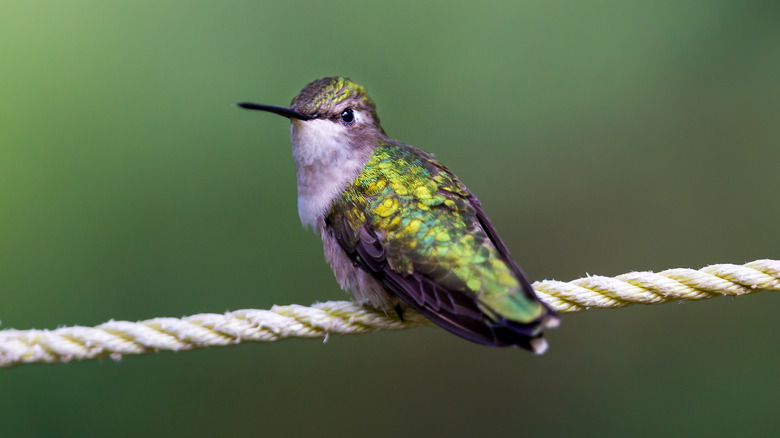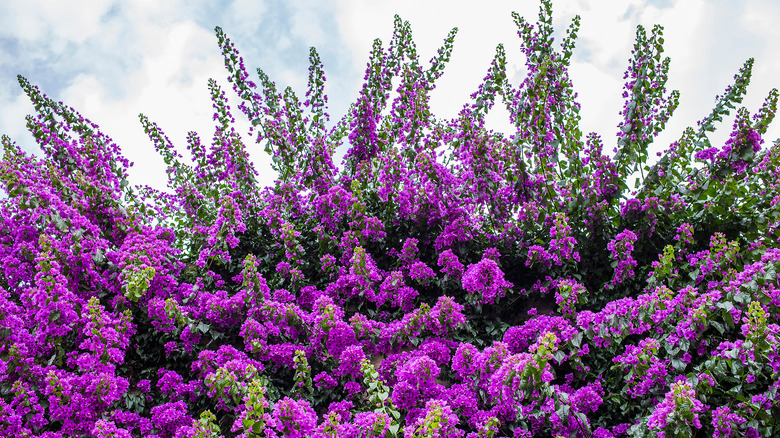This Stunning Tree With Long-Lasting Purple Blooms Is A Hummingbird Magnet
Trees rarely spring to mind when considering plants to attract hummingbirds to your garden. Typically, annual or perennial groundcovers or, at tallest, shrubs, with bountiful flowers that hummingbirds absolutely love are the go-to options. But you're doing yourself a disservice skipping bigger greenery. Trees with spring or summer blooms not only satiate voracious hummingbird appetites, they also add much needed dimension and shade to a garden. Not every tree, however, will do. You need one with abundant flowers in hummer-favored hues with lots of pollen or nectar. Such a tree, at least for those living in USDA Hardiness Zones 6 to 9, is the 'Twilight' crepe myrtle.
The 'Twilight' crepe myrtle — sometimes written "crape myrtle" or "crapemyrtle" — is a Lagerstroemia or crepe myrtle species cultivar with glossy green leaves and crumpled, dark purple to light lavender blooms, a hue resembling that of the night sky just after the sun sets. Lagerstroemia indica 'Twilight' is the tree's scientific name. Note that there's also the trademarked Crepe Myrtle 'Twilight Magic' (cultivar name Lagerstroemia 'PIILAG-VIII' PP27194), which has hot pink flowers and purple leaves. There are small, medium, and large crepe myrtles, and 'Twilight' falls into the third category, reaching up to 25 feet high and 15 feet wide in ideal conditions. It's also fast growing and long-lived tree, living about two decades. Plant a sapling and you can expect it to double in size over the next half-decade.
What is it about the 'Twilight' crepe myrtle that hummingbirds love?
If hummingbirds are steering clear of your yard, planting a 'Twilight' crepe myrtle is bound to bring them back. 'Twilight' cultivars have a long summer blooming period. They flower for over two months, starting in early June, keeping hungry hummers around through the summer and well into the fall. Plus, hummingbirds gravitate toward brightly colored flowers like purple and pink, something 'Twilight' crepe myrtles have in abundance. Crepe myrtles don't just attract hummingbirds, either. Insects like carpenter bees, butterflies, and smaller bugs that hummingbirds like to eat come for the nectar and pollen. Crepe myrtles are often the star ornamental in a garden, especially when the tree is easily seen from a window or while sitting on a porch or patio. That, incidentally, makes for great hummingbird watching! What's more, the spindly twigs of the crepe myrtle are favored perches for hummingbirds guarding nearby feeders.
There are other reasons to plant a 'Twilight' crepe myrtle outside of good looks and attractiveness to pollinators, hummingbirds included. The cultivar is exceedingly drought tolerant and resistant to most common crepe myrtle diseases and pests, including powdery mildew and Cercospora leaf spot. You still need to watch out for the crepe myrtle aphid, though. Herbivorous mammals — looking at you, deer and rabbit — won't be tempted to have a nibble, either. For those that don't have in-ground space, 'Twilight' also does pretty well in (admittedly large) containers.
What you should know about growing a 'Twilight' crepe myrtle for hummingbirds
'Twilight' crepe myrtle isn't without its downsides. It's native to eastern Asia, not the U.S., and some experts consider introduced species disruptive for or unsupportive of local ecosystems. The plant is deciduous, so that attractive red-orange fall foliage means lots of leaf raking. The bark also starts to peel off the crepe myrtles trunk in the fall. Crepe myrtle trees also have shallow root systems — don't use them to stabilize your soil. Planting them in the shade reduces the number and vibrancy of the flowers. As a 'Twilight' cultivar tree, the hue of its blooms may also grow duller, and planting them in a container can have the same effect.
The Arbor Day Foundation sells fuschia-pink blooming 'Twilight Magic' crepe myrtles in one-gallon pots for under $60. Get a violet-hued 'Twilight' crepe myrtle in a three-gallon pot for just over $70 from Wilson Bros Gardens. While your sapling's on its way, read up on must-know care tips to ensure a healthy and thriving crepe myrtle tree. Most importantly, choose a location with as much sun as possible to ensure healthy blooms. The soil type doesn't matter so much, as long as it's well-draining. Feeding with a slow release fertilizer in winter or spring will also result in abundant flowering come summer.

